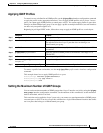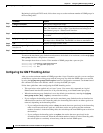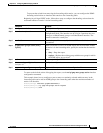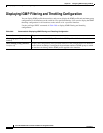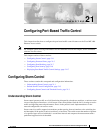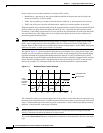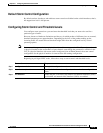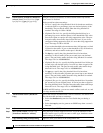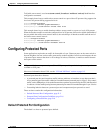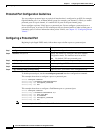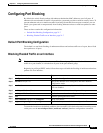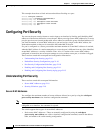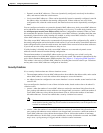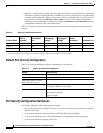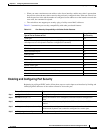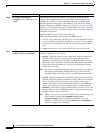
21-5
Cisco ME 3400 Ethernet Access Switch Software Configuration Guide
78-17058-01
Chapter 21 Configuring Port-Based Traffic Control
Configuring Protected Ports
To disable storm control, use the no storm-control {broadcast | multicast | unicast} level interface
configuration command.
This example shows how to enable unicast storm control on a port with an 87-percent rising suppression
level and a 65-percent falling suppression level:
Switch# configure terminal
Switch(config)# interface gigabitethernet0/1
Switch(config-if)# storm-control unicast level 87 65
This example shows how to enable broadcast address storm control on a port to a level of 20 percent.
When the broadcast traffic exceeds the configured level of 20 percent of the total available bandwidth of
the port within the traffic-storm-control interval, the switch drops all broadcast traffic until the end of
the traffic-storm-control interval:
Switch# configure terminal
Switch(config)# interface gigabitethernet0/1
Switch(config-if)# storm-control broadcast level 20
Configuring Protected Ports
Some applications require that no traffic be forwarded at Layer 2 between ports on the same switch so
that one neighbor does not see the traffic generated by another neighbor. In such an environment, the use
of protected ports ensures that there is no exchange of unicast, broadcast, or multicast traffic between
these ports on the switch.
Note NNI ports default to non-protected ports. Since UNI ports provide port isolation, protected port is not
available on UNI ports.
More more information about UNIs, see the “UNI and NNI Ports” section on page 9-3.
Protected ports have these features:
• A protected port does not forward any traffic (unicast, multicast, or broadcast) to any other port that is
also a protected port. Data traffic cannot be forwarded between protected ports at Layer 2; only control
traffic, such as PIM packets, is forwarded because these packets are processed by the CPU and forwarded
in software. All data traffic passing between protected ports must be forwarded through a Layer 3 device.
• Forwarding behavior between a protected port and a nonprotected port proceeds as usual.
These sections contain this configuration information:
• Default Protected Port Configuration, page 21-5
• Protected Port Configuration Guidelines, page 21-6
• Configuring a Protected Port, page 21-6
Default Protected Port Configuration
The default is to have no protected ports defined.



